Adsorption of metal atoms on silicene: stability and quantum capacitance of silicene-based electrode materials
Abstract
We explore the adsorption stability and quantum capacitance of transition metal atoms on silicene based on first-principles calculations. Silicene with a buckled atomic layer has a high surface/volume ratio and silicene-based materials are expected to have potential applications for supercapacitors. We find that the most favorable adsorption sites on pristine silicene are valley sites for Al and Ti, and hollow sites for Ag, Cu and Au, respectively. Among all these systems with the doping of metal atoms, silicene is modulated to possess a quasi-metallic characteristic, accompanied by an appreciable electron transfer and the formation of defect states near the Fermi level. Due to the low density of states near the Fermi level, the quantum capacitance of pristine silicene has been limited. By the doping of metal atoms, especially Ti atoms, with the introduction of localized defect states near the Fermi level, quantum capacitance is found to be enhanced significantly. In addition, the quantum capacitance is found to increase monotonically following the increase of doping concentrations.



 Please wait while we load your content...
Please wait while we load your content...